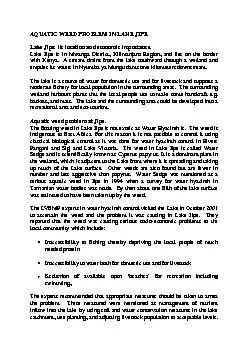

Lake Jipe its location and economic importance Lake Jipe is in Mwanga District Kilimanjaro Region and lies on the border with Kenya A stream drains from the lake southward through a wetland a ID: 829769
Download Pdf The PPT/PDF document "AQUATIC WEED PROBLEM IN LAKE JIPE" is the property of its rightful owner. Permission is granted to download and print the materials on this web site for personal, non-commercial use only, and to display it on your personal computer provided you do not modify the materials and that you retain all copyright notices contained in the materials. By downloading content from our website, you accept the terms of this agreement.
1 AQUATIC WEED PROBLEM IN LAKE JIPE La
AQUATIC WEED PROBLEM IN LAKE JIPE Lake Jipe: its location and economic importance. Lake Jipe is in Mwanga District, Kilimanjaro Region, and lies on the border with Kenya. A stream drains from the lake southward through a wetland and empties its waters in Nyumba ya Mungu dam some kilometers downstream. The lake is a source of water for domestic use and for livestock and supports a moderate fishery for local population in the surrounding areas. The surrounding wetland harbours plants that the local pe ople use to make some handcraft e.g. baskets, and mats. The lake and the surrounding area could be developed into a recreational area and eco - tourism. Aquatic weed problem at Jipe. The floating weed in Lake Jipe is not exotic as Water Hyacinth is. The w eed is indigenous to East Africa. For this reason it is not possible to control it using classical biological control as it was done for water hyacinth control in Rivers Pangani and Sigi and Lake Victoria. The weed in Lake Jipe is called Water Sedge and i s scientifically known as Cyperus papyrus. It is a dominant plant in the wetland, which is adjacent to the Lake from where it is spreading and taking up much of the Lake surface. Other weeds are also found but are fewer in number and less aggressive than papyrus. Water Sedge was mentioned as a serious aquatic weed in Jipe in 1994 when a survey for water hyacinth in Tanzanian water bodies was made. By then about one fifth of the lake surface was estimated to have been taken up by the weed. The LVEMP expe rts in water hyacinth control visited the Lake in October 2001 to ascertain the weed and the problem it was causing in Lake Jipe. They reported that the weed was causing serious socio - economic problems to the local community which include: Inaccessibili ty to fishing thereby depriving the local people of much needed protein. Inaccessibility to water both for domestic use and for livestock Reduction of available open ‘beaches’ for recreation including swimming, The experts recommended that appropriate measures should be taken to arrest the problem. These measured were mentioned as management of nutrient inflow into the lake by using soil and water conservation measures in the lake catchment, tree planting, and adjusting livestock population to acceptab le levels. Awarene
2 ss creation to the local community on th
ss creation to the local community on the weed problem and the need to manage the weed and their full involvement and participation was also cited as key to success in the management of the weed. Wetlands are known to act as buffer for nutrients that would otherwise drain into adjacent water bodies. Although buffering capacity of Jipe wetland is yet to be studied, there is no doubt the wetland offers some protection for Nyumba ya Mungu into which it drains. Favourable factors for weed proliferation Factors that have led to weed proliferation in Lake Jipe are yet to be investigated. However, weed proliferation in aquatic systems is known to be favoured by among other things, high nutrient levels that drain into them from the surrounding catchment. This is not exceptional for Jipe as the surrounding areas are characterized by inappropriate land use practices without soil and water conservation structures, loss of tree and vegetation cover, and overgrazing. Strategies for managing aquati c weed problem at Jipe Currently there are no measures taken to manage the aquatic weed problem in Lake Jipe. In the absence of any control measures, the aforementioned problems will escalate as the weeds take up more of the Lake surface. To arrest this situation, a long - term strategy should be put in place to manage the weed problem in Jipe. The strategy should not only target the weeds directly but also the factors that contribute to favourable conditions for weed growth. This means the weed should be controlled directly and indirectly. The strategy should be integrated in approach to involve all actors, which will contribute in minimizing nutrient inputs into the Lake, and ultimately reduce aquatic weed proliferation in Lake Jipe. These will include Crop production specialists, farmers and livestock keepers, Village leaders, land use planners, foresters, experts in Community Development, wetlands, water quantity and quality, and District authorities, NGOs, and so on. This team of actors will need to draw up a Management Plan for Lake Jipe Catchment, based on the existing problems and prioritized solutions and see its implementation. Lake Jipe being a shared water body between Kenya and Tanzania, there is need to harmonize the management plans with Ke nya so that the Lake basin is managed as a shared ecosystem